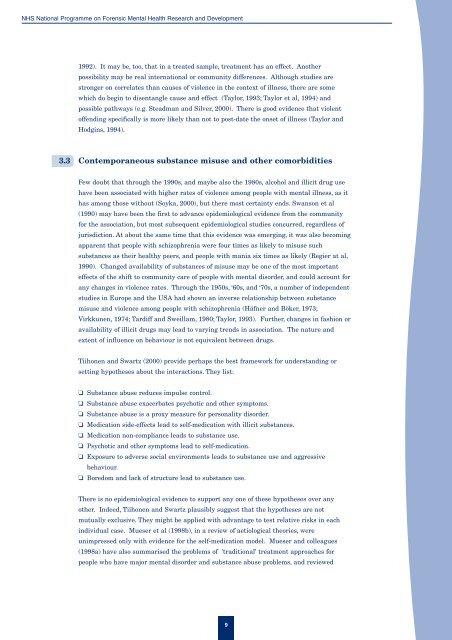Mental Illness and Serious Harm to Others - University of Liverpool
Mental Illness and Serious Harm to Others - University of Liverpool
Mental Illness and Serious Harm to Others - University of Liverpool
You also want an ePaper? Increase the reach of your titles
YUMPU automatically turns print PDFs into web optimized ePapers that Google loves.
NHS National Programme on Forensic <strong>Mental</strong> Health Research <strong>and</strong> Development<br />
1992). It may be, <strong>to</strong>o, that in a treated sample, treatment has an effect. Another<br />
possibility may be real international or community differences. Although studies are<br />
stronger on correlates than causes <strong>of</strong> violence in the context <strong>of</strong> illness, there are some<br />
which do begin <strong>to</strong> disentangle cause <strong>and</strong> effect (Taylor, 1993; Taylor et al, 1994) <strong>and</strong><br />
possible pathways (e.g. Steadman <strong>and</strong> Silver, 2000). There is good evidence that violent<br />
<strong>of</strong>fending specifically is more likely than not <strong>to</strong> post-date the onset <strong>of</strong> illness (Taylor <strong>and</strong><br />
Hodgins, 1994).<br />
3.3 Contemporaneous substance misuse <strong>and</strong> other comorbidities<br />
Few doubt that through the 1990s, <strong>and</strong> maybe also the 1980s, alcohol <strong>and</strong> illicit drug use<br />
have been associated with higher rates <strong>of</strong> violence among people with mental illness, as it<br />
has among those without (Soyka, 2000), but there most certainty ends. Swanson et al<br />
(1990) may have been the first <strong>to</strong> advance epidemiological evidence from the community<br />
for the association, but most subsequent epidemiological studies concurred, regardless <strong>of</strong><br />
jurisdiction. At about the same time that this evidence was emerging, it was also becoming<br />
apparent that people with schizophrenia were four times as likely <strong>to</strong> misuse such<br />
substances as their healthy peers, <strong>and</strong> people with mania six times as likely (Regier at al,<br />
1990). Changed availability <strong>of</strong> substances <strong>of</strong> misuse may be one <strong>of</strong> the most important<br />
effects <strong>of</strong> the shift <strong>to</strong> community care <strong>of</strong> people with mental disorder, <strong>and</strong> could account for<br />
any changes in violence rates. Through the 1950s, ‘60s, <strong>and</strong> ‘70s, a number <strong>of</strong> independent<br />
studies in Europe <strong>and</strong> the USA had shown an inverse relationship between substance<br />
misuse <strong>and</strong> violence among people with schizophrenia (Häfner <strong>and</strong> Böker, 1973;<br />
Virkkunen, 1974; Tardiff <strong>and</strong> Sweillam, 1980; Taylor, 1993). Further, changes in fashion or<br />
availability <strong>of</strong> illicit drugs may lead <strong>to</strong> varying trends in association. The nature <strong>and</strong><br />
extent <strong>of</strong> influence on behaviour is not equivalent between drugs.<br />
Tiihonen <strong>and</strong> Swartz (2000) provide perhaps the best framework for underst<strong>and</strong>ing or<br />
setting hypotheses about the interactions. They list:<br />
❑ Substance abuse reduces impulse control.<br />
❑ Substance abuse exacerbates psychotic <strong>and</strong> other symp<strong>to</strong>ms.<br />
❑ Substance abuse is a proxy measure for personality disorder.<br />
❑ Medication side-effects lead <strong>to</strong> self-medication with illicit substances.<br />
❑ Medication non-compliance leads <strong>to</strong> substance use.<br />
❑ Psychotic <strong>and</strong> other symp<strong>to</strong>ms lead <strong>to</strong> self-medication.<br />
❑ Exposure <strong>to</strong> adverse social environments leads <strong>to</strong> substance use <strong>and</strong> aggressive<br />
behaviour.<br />
❑ Boredom <strong>and</strong> lack <strong>of</strong> structure lead <strong>to</strong> substance use.<br />
There is no epidemiological evidence <strong>to</strong> support any one <strong>of</strong> these hypotheses over any<br />
other. Indeed, Tiihonen <strong>and</strong> Swartz plausibly suggest that the hypotheses are not<br />
mutually exclusive. They might be applied with advantage <strong>to</strong> test relative risks in each<br />
individual case. Mueser et al (1998b), in a review <strong>of</strong> aetiological theories, were<br />
unimpressed only with evidence for the self-medication model. Mueser <strong>and</strong> colleagues<br />
(1998a) have also summarised the problems <strong>of</strong> 'traditional' treatment approaches for<br />
people who have major mental disorder <strong>and</strong> substance abuse problems, <strong>and</strong> reviewed<br />
9
















